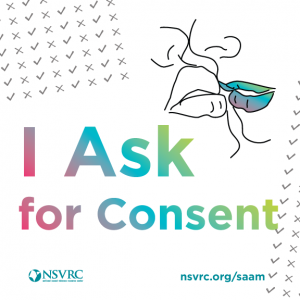“Hey, do you have a minute?”
“Wonderful! I was hoping we could talk about consent, either now or at a time that is more convenient for you. Is that a conversation that interests you?”
The theme for the 2019 Sexual Assault Awareness Month is I Ask. In part, this theme is meant to highlight the need to ask for consent prior to engaging in sexual activity. Consent refers to an enthusiastically communicated willingness, without hesitation or reservation, to participate in a specific sexual activity. Consent is having a choice and a VOICE.
Voluntary
For a sexual act or activity to be consensual, all parties must enter into it voluntarily. If pressure, manipulation, deception, or coercion are involved in the prelude to sexual acts or activities, they were not entered into voluntarily.
Ongoing
We are responsible for constantly checking on consent. Consent to one sexual act or activity does not imply consent to other sexual acts or activities. Consent can be withdrawn at any time, for any reason. This applies to duration. Someone may decide two minutes into kissing another person that they are no longer willing. It also applies to recurrence. Someone willing to engage in sexual activity Friday may decline the same activity with the same partner on Saturday.
Informed
Sexual partners must be aware of the risks around sex and the circumstances of the relationship. This includes sharing sexual histories, disclosing any sexually transmitted infections, being upfront and honest regarding relational intentions, and being forthright about current relational commitments.
Clear
Healthy sexuality involves clearly communicating what activities are being suggested. It also involves being upfront about levels of interest. ‘Playing coy,’ feigning disinterest, is not conducive to the establishment of consent.
Enthusiastic
“I suppose I could” does not indicate an enthusiastic willingness to participate. Someone jumping up and down and saying, “PICK ME! PICK ME!” does. It is important that intimate partners lean firmly toward the “OH YEAH” end of the enthusiasm spectrum. Desire should be conveyed both verbally (what you are hearing) non-verbally (what you are seeing) and kinesthetically (what you are feeling).
Establishing consent requires hearing, seeing, and feeling outward demonstrations of willingness to engage. Verbally, someone might say: “That feels good,” “yes,” “absolutely,” “oh wow,” or “please keep doing that.” Non-verbally, consent may look like someone moving toward you, meeting you part way, making eye contact, smiling, blushing, or revealing more of their body. Consent may feel like someone is responsive to touch, mirroring your movements, touching you, or initiating other sexual acts and activities.
If healthy sexuality is the goal, we must learn to be more proactive in establishing consent, rather than simply being prepared to pause and check in or discontinue sexual activity when a line is crossed. Any sexual contact, behavior, or activity without the explicit consent of each participant, is sexual assault.
Sexual violence is a form of sexual harassment in which sexual or intimate acts are performed without full and informed consent. There are situations where one or more persons are incapable of giving consent for a variety of reasons. These include, but are not limited to: participant age, intoxication, consciousness, and power imbalances. The following additional resources expand on this topic:
- Consent: It’s as Simple as Tea
- Cycling through Consent
- Planned Parenthood: All about Consent
- What Consent Looks Like, RAINN
Taking a more proactive approach to consent requires creating relationships where open and honest communication takes place. It also involves listening intently, with all of our senses, to what is said, body language, tone of voice, and what we feel in response to our words and actions. Proactive consent requires respecting boundaries and gracefully accepting rejection, without questioning or demanding explanations. Conversations about sex and intimacy are becoming less taboo and stigmatized, allowing scrutiny of our dealing with consent and related topics in ways that are more nuanced than ever before.
“Thank you for joining me for this conversation. I hope that moving forward you take time to think about, talk about, and ASK for consent!”
Additional reading
- #ISUAsks important questions for Sexual Assault Awareness Month
- Communicating consent outside of the bedroom and beyond
- Denim Day coming to the Quad April 24
- Hidden pain: ISU scholar interviews mothers of sexual assault victims
- Redbird Respect: Continuing sexual assault conversations beyond the month of April
- Redbird Respect: Fostering a sense of community by reducing the bystander effect
- SERC looks to bring visibility to rape culture, create space for survivors
- Understanding the effects of trauma


